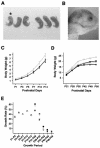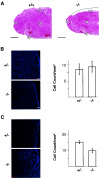Role of Plk2 (Snk) in mouse development and cell proliferation
- PMID: 12972611
- PMCID: PMC193943
- DOI: 10.1128/MCB.23.19.6936-6943.2003
Role of Plk2 (Snk) in mouse development and cell proliferation
Abstract
Plk2 (Snk) is a polo-like kinase expressed at G(1) in cultured cells and mainly in the hippocampal neurons in the brains of adult rodents, but its function is poorly understood. We have generated mice deficient in Plk2 by gene targeting. Although Plk2 is not required for postnatal growth, Plk2(-/-) embryos show retarded growth and skeletal development late in gestation. The labyrinthine zone of the placenta is diminished in Plk2(-/-) embryos due to decreased cell proliferation. Cultured Plk2(-/-) embryonic fibroblasts grow more slowly than normal cells and show delayed entry into S phase. These data suggest a role for Plk2 in the cell cycle.
Figures





Similar articles
-
Polo-like kinase-2 is required for centriole duplication in mammalian cells.Curr Biol. 2004 Jul 13;14(13):1200-7. doi: 10.1016/j.cub.2004.06.059. Curr Biol. 2004. PMID: 15242618
-
Silencing of the novel p53 target gene Snk/Plk2 leads to mitotic catastrophe in paclitaxel (taxol)-exposed cells.Mol Cell Biol. 2003 Aug;23(16):5556-71. doi: 10.1128/MCB.23.16.5556-5571.2003. Mol Cell Biol. 2003. PMID: 12897130 Free PMC article.
-
Transcriptional silencing of Polo-like kinase 2 (SNK/PLK2) is a frequent event in B-cell malignancies.Blood. 2006 Jan 1;107(1):250-6. doi: 10.1182/blood-2005-03-1194. Epub 2005 Sep 13. Blood. 2006. PMID: 16160013
-
The Plk3-Cdc25 circuit.Oncogene. 2005 Jan 10;24(2):299-305. doi: 10.1038/sj.onc.1208278. Oncogene. 2005. PMID: 15640846 Review.
-
Polo-like kinases: a team in control of the division.Cell Cycle. 2006 Apr;5(8):853-64. doi: 10.4161/cc.5.8.2692. Epub 2006 Apr 17. Cell Cycle. 2006. PMID: 16627997 Review.
Cited by
-
Systemic mesalazine treatment prevents spontaneous skin fibrosis in PLK2-deficient mice.Naunyn Schmiedebergs Arch Pharmacol. 2021 Nov;394(11):2233-2244. doi: 10.1007/s00210-021-02135-w. Epub 2021 Aug 19. Naunyn Schmiedebergs Arch Pharmacol. 2021. PMID: 34410453 Free PMC article.
-
Single-cell RNA-seq reveals changes in cell cycle and differentiation programs upon aging of hematopoietic stem cells.Genome Res. 2015 Dec;25(12):1860-72. doi: 10.1101/gr.192237.115. Epub 2015 Oct 1. Genome Res. 2015. PMID: 26430063 Free PMC article.
-
From Plk1 to Plk5: functional evolution of polo-like kinases.Cell Cycle. 2011 Jul 15;10(14):2255-62. doi: 10.4161/cc.10.14.16494. Epub 2011 Jul 15. Cell Cycle. 2011. PMID: 21654194 Free PMC article. Review.
-
Polo-like kinases (plks), a key regulator of cell cycle and new potential target for cancer therapy.Dev Reprod. 2014 Mar;18(1):65-71. doi: 10.12717/DR.2014.18.1.065. Dev Reprod. 2014. PMID: 25949173 Free PMC article.
-
Putting a bit into the polo-box domain of polo-like kinase 1.J Anal Sci Technol. 2015;6(1):27. doi: 10.1186/s40543-015-0069-y. Epub 2015 Oct 14. J Anal Sci Technol. 2015. PMID: 26500787 Free PMC article. Review.
References
-
- Alexandru, G., F. Uhlmann, K. Mechtler, M. A. Poupart, and K. Nasmyth. 2001. Phosphorylation of the cohesin subunit Scc1 by Polo/Cdc5 kinase regulates sister chromatid separation in yeast. Cell 105:459-472. - PubMed
-
- Charron, J., B. A. Malynn, P. Fisher, V. Stewart, L. Jeannotte, S. P. Goff, E. J. Robertson, and F. W. Alt. 1992. Embryonic lethality in mice homozygous for a targeted disruption of the N-myc gene. Genes Dev. 6:2248-2257. - PubMed
-
- Conn, C. W., R. F. Hennigan, W. Dai, Y. Sanchez, and P. J. Stambrook. 2000. Incomplete cytokinesis and induction of apoptosis by overexpression of the mammalian polo-like kinase, Plk3. Cancer Res. 60:6826-6831. - PubMed
Publication types
MeSH terms
Substances
Grants and funding
LinkOut - more resources
Full Text Sources
Other Literature Sources
Molecular Biology Databases
